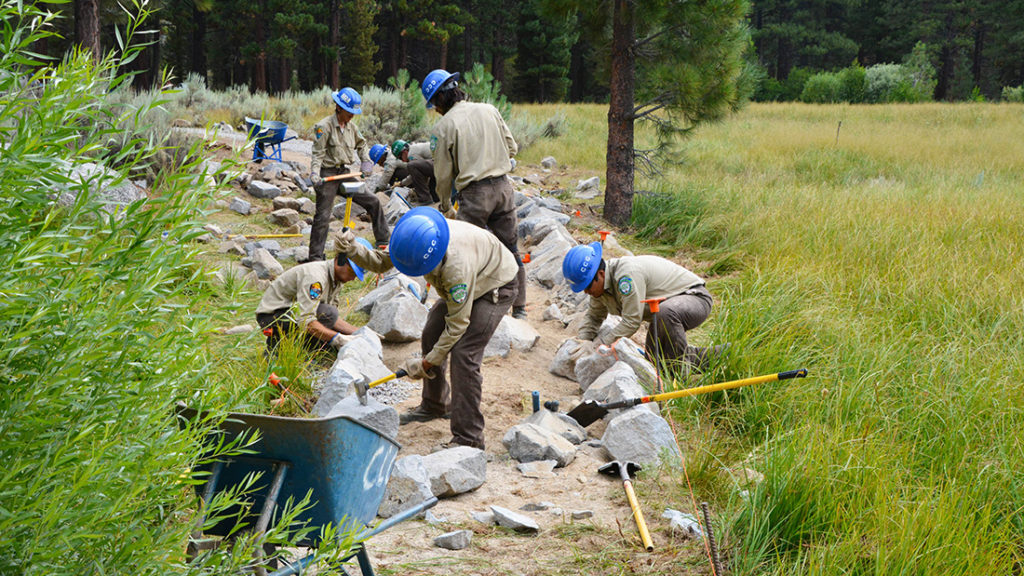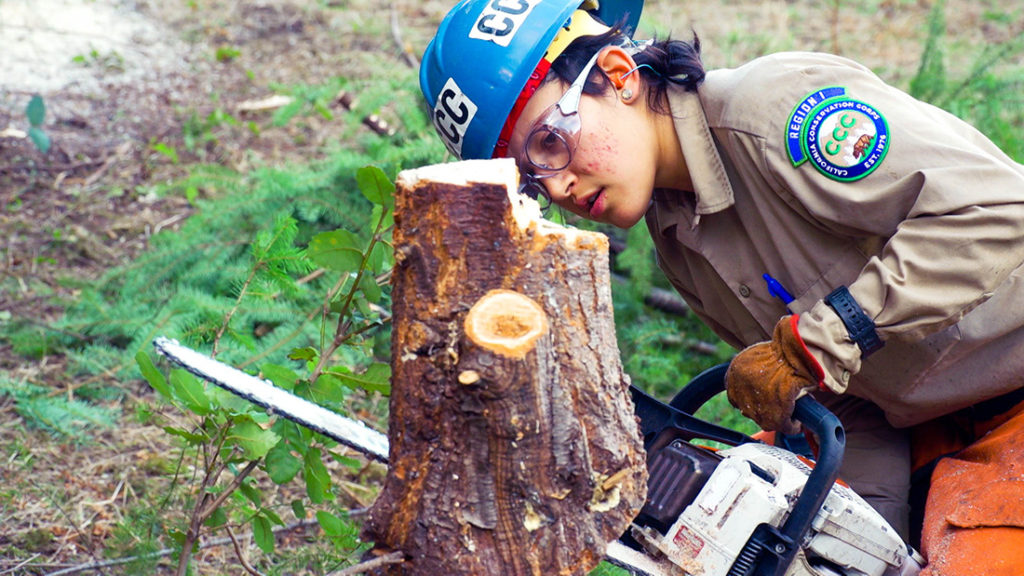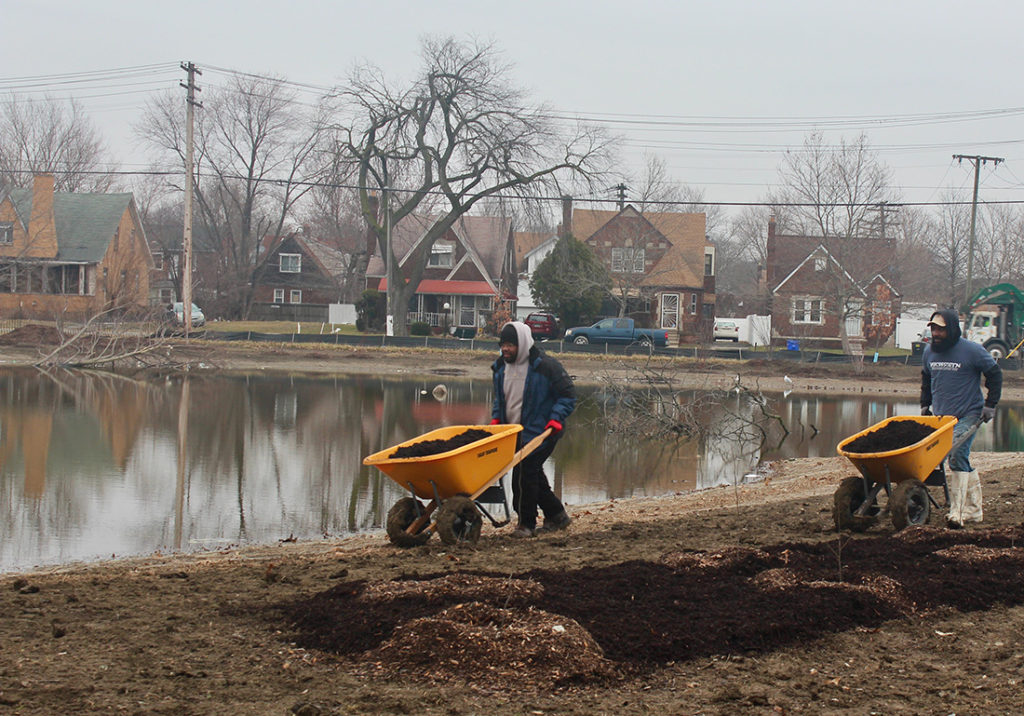
“Hard work, low pay, miserable conditions, and more!”
On its face, the California Conservation Corps’ motto might seem like more of a warning than a recruiting tool, but for thousands, it represents a promise: new skills, entry to a career, even a bit of an adventure.
And it fairly describes the work of roughly 3,400 young people the state agency trains each year for jobs in forestry and other conservation fields.
Planting tree seedlings on steep hillsides on hot summer days and thinning forests of dense vegetation so trees already planted there have room to grow is hard work.
Growing and taking care of trees in cities is also hard. Digging large holes for hardy trees that can withstand relatively harsh city environments and climbing trees to prune branches so they won’t fall on cars and houses can be exhausting.
Yet it’s the kind of work we desperately need more people to do as interest in trees as a solution to climate change and social inequity takes off across America.
And, despite how arduous this work is, the opportunity couldn’t come at a better time. As of August, 1 in 10 Americans was unemployed. People from under-resourced communities in cities and rural areas — two places that have the highest potential for forestry jobs — are among the hardest hit by the recession.
Though they might begin in entry-level positions, Zander Evans, the Executive Director of the Santa Fe-based Forest Stewards Guild, says that people in forestry can soon find themselves running drones, doing mapping and even communicating with residents about prescribed burns.
“There is a career ladder,” he says. Making sure that ladder is accessible to those who need it most is more important than ever. One of the best ways to do that is through job training programs such as the California Conservation Corps, which focuses much of its Corps member recruitment on under-resourced communities.
Growing up in a low-income family in a Los Angeles suburb, Luna Morales’ main exposure to nature was a yearly trip to a state park.

After two years in the California program, Morales, now 21, can fell trees with a chainsaw and help reroute creeks. She was promoted to crew leader and is working toward her associate’s degree. “With the background I came from,” Morales says, “I never would have expected to be here.”
“The Cs,” as its members call it, was created by the state of California in 1976. Modeled loosely after the national Civilian Conservation Corps that put 3 million people to work during the Great Depression, it is a state agency and a model American Forests and others believe could be replicated during the current recession.
Corps members receive a $1,905 monthly stipend while getting on-the-job training in everything from building and clearing trails to cutting down dead trees and responding to natural and manmade disasters. American Forests works with the group on a number of planting and shrub-clearing projects.
Workforce development programs are also key in urban areas — especially low-income neighborhoods and some communities of color, which tend to have fewer trees and the highest unemployment. The need for people who can plant, trim and prune trees in cities is expected to grow 10% by 2028.
That’s why American Forests works with job training partners in several cities to support and increase capacity for urban forestry programs, through its Tree Equity: Career Pathways Initiative. They have also developed a guide for creating entry-level urban forestry career pathways programs that target people in communities who could benefit most from entering the field.
“It’s definitely a moment where we’re crystal clear about the cost of inaction on our forests, and we are crystal clear about the coordinated effort that it’s going to take to actually make significant change,” says Sarah Lillie Anderson, senior manager of American Forests’ Tree Equity programs.

Take William Rucker of Detroit, for example. He had never held a job outside of prison, which he was released from in 2019. He enrolled in an urban forestry training program offered by The Greening of Detroit, a nonprofit that plants trees and provides education and workforce development for people from under-resourced communities, many of them formerly incarcerated.
Rucker has since been hired by “The Greening,” one of American Forests’ partners, and also started his own landscaping business, serving about 30 houses a day. He plans to expand soon and put others to work.
“I’m hiring people from The Greening because I know they’ve been taught, they have qualifications and I can depend on them to show up for work every day,” he says.
Besides forestry skills training, the organization provides a range of support services, helping participants with transportation and housing, as well as basic training about being on time for work. These “wraparound” support services have contributed mightily toward the program’s 87% job placement rate, says Vice President Monica Tabares.
“Rarely have we had an opportunity to address two huge crises, climate change and the economy, at the same time,” says Jad Daley, President of American Forests. “This is the moment to be bold.”
Read the full story about how investing in our forests can help create jobs in American Forests’ magazine.
Michele Kurtz is the Director of Communications at American Forests.
